China is getting ready to launch the first piece of its permanent space station this week, say the country’s space agency, providing the Long March 5B carrier rocket that will loft the core module into orbit successfully completes its pre-launch examinations.
China’s space agency moved the Long March to the Wenchang Space Launch Center on the southern island of Hainan in preparation for the flight on 23 April.
According to China’s state-run news site, sources close to the mission said the equipment at the coastal launch centre is in good condition and personnel involved in the launch mission are making preparations. Liftoff is expected imminently.
Considered China's most sophisticated space endeavour, the multi-module space station, named Tiangong, or Heavenly Palace, will have a combined weight of more than 90 metric tons.
The launch of its 16.6 metre long core module, the Tianhe, or "Heavenly Harmony”, will be the first of 11 missions to transport and build the orbital station.
After the module is launched, astronauts on the Shenzhou XII and XIII missions and two cargo ships will be launched within a few months to prepare the module for docking with other parts of the station.
Its two space laboratories, ‘Wentian' and 'Mengtian' will be launched in separate Long March 5B missions and once complete the outpost will form a T-shaped structure that can house a total of six astronauts on stays of up to six months.
China is aiming to have its space station fully operational by next year and its expected lifetime is around 15 years, the programme’s planners have said.
Striking while the iron is hot, speaking at a space conference, held in Nanjing, east China's Jiangsu Province on Saturday, the chief designer of the third stage of China's lunar exploration program, Hu Hao, said the country is aiming to launch its Chang'e 6 probe to the far side of the moon around 2024.
The backup to China’s Chang'e-5 mission, which successfully brought back 1,731 grams of moon samples in 2020, Chang'e-6 would also collect lunar samples automatically for comprehensive analysis and research.
It will target the South Pole-Aitken (SPA) Basin, an immense impact crater roughly 2,500 kilometres in diameter and between 6.2 and 8.2 kilometres deep.
Research on the region’s stratigraphy – the study of rock layers (strata) – show that SPA is the oldest impact basin on the moon, but scientists are intensely interested in just how old it is.
The China National Space Administration has already invited scientists around the world to participate in the mission and four payloads developed by scientists from France, Italy, Sweden, Russia and China have been preliminarily selected.
After the detailed plan of the Chang'e-6 mission comes out, the payloads will be finally determined, Hao said.











